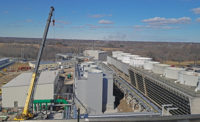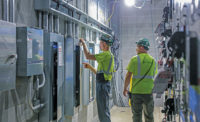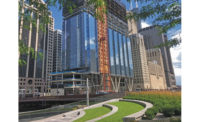Related Link:
ENR Midwest 2023 Top Contractors
As many workers and companies still embrace hybrid and remote models established during the COVID-19 pandemic—even several years out from its onset—impacts on construction continue, with some sectors thriving and others diminishing. Despite the changing landscape, contractors continued to see solid performance overall across the 11-state Midwest region.
Out of the 80 companies featured on ENR Midwest’s 2023 Top Contractors ranking, the top 25 firms posted a combined $40.64 billion in 2022 regional revenue, showing steady growth compared to the $35.59 billion reported by the top 25 firms in the year-ago period.
“It’s a tale of two economies,” observes Bob Clark, executive chairman and founder of Clayco. “Commercial urban development is going to hit the rocks. Office will be toxic for the most part due to the incredibly high vacancies and higher interest rates in the near term.”
But he notes that contractors who are able to travel and execute design-build work are thriving and will be overwhelmed with opportunities in advanced manufacturing, food and beverage, industrial, green energy projects and cloud scale data centers.
Across the Midwest, Clayco has seen a large uptick in contracts and pipelines in its aviation, industrial, institutional and manufacturing businesses, Clark says. “Legislation including the CHIPS Act and Inflation Reduction Act and the demand for onshoring stemming from the COVID-era supply chain constraints all helped 2022 and set the table for 2023,” he says. “This momentum has continued this year and further expanded with the spike in AI adoption and increased velocity of manufacturing.”
Some markets will remain strong, as they are more essential and less influenced by economic forces, notes John Buescher, president of the Central region at McCarthy Building Cos. “These include water and wastewater treatment facilities, renewable/solar energy, health care, higher education institutional facilities and industrial process and manufacturing facilities,” he says.
There are also more government funded and/or assisted projects coming along thanks to programs such as the American Rescue Plan Act, Infrastructure Investment and Jobs Act and other programs that are funding both the public and private sectors, Buescher adds. “We will keep an eye on interest rates in the long term. As inflation recently has slowed, there is hope that rates will start to be lowered in the next 12 to 24 months.”
Navigating the Waters
“Regardless of various economic indicators, business is strong throughout the Midwest and the country,” says Chuck Binkowski, COO at Barton Malow Holdings. “There are always going to be challenges and the potential for disruption, which will continue to evolve as the pace of change gets faster. The pace of change has never been this fast, yet it will never be this slow again.”
Barton Malow’s commercial and institutional division is seeing professional and collegiate sports as its most significant growth market. Another growing sector is health care.
As for its industrial and union-based division, “growth in electric vehicle battery manufacturing facilities has been exponential,” Binkowsi says. “That’s driven much of our revenue growth in the Midwest and throughout the country. Projects like Ultium Cells and BlueOval SK are aiming to electrify the future of mobility.”
For Clune Construction Co., diversification has helped keep its book of business up, says Vince Gutekanst, president, Midwest region. “Chicago is probably our primary market for tenant interiors, and that has still been lagging as far as people coming back to work,” he says. “Occupancies are way down, and the hybrid work environment is impacting getting deals done in the city.”
Better preplanning has mostly mitigated the market volatility and long lead times seen over the last year, Gutekanst says. “But in 2023, Chicago has been—knock on wood—pretty solid for us in all of our major markets,” he says.
Thanks to a strong workforce with the skill set to do more technical jobs, Clune has been able to shift resources over to assist and even run some larger mission critical jobs. “We’ve been fortunate in that we’ve got good diversification. We picked up some work at a couple of the airports here, and that vertical will continue to improve,” Gutekanst says. “Health care is still a little lagging for us, but there are opportunities.”
Meanwhile, Miron Construction Co. continues to see strength in its main markets, including food, energy, health care and education, says Tim Kippenhan, vice president and COO. “Owners do appear to be more cautious in their capital expenditures,” he says. “Continued construction cost escalation does give us concern that more projects will be slowed or placed on hold in the coming year.”
Chicagoland area business continues to be steady for McShane Construction Co. Although 2023 is tracking similar to 2022 in business and revenue, new business signings have slowed somewhat as capital markets determine how to account for rising interest rates and bank stress, says Mathew Dougherty, company president.
Business is steady in its core markets of multifamily and industrial across the region, but “the biggest challenge we’re currently facing is the impact capital markets are having on deal flow moving forward,” he says. “We’re seeing new projects taking longer to close as capital has become tighter. We do remain optimistic given the high demand and strong market fundamentals in both multifamily and industrial property types.”
Eyes Ahead
Industry leaders agree that inflation and interest rates will continue to be an issue for construction moving forward. But one of the Midwest’s perks is its resilience despite economic uncertainty.
Moving toward the end of 2023 and beyond, “It will be a strong case of the haves and the have nots,” Clark notes. “Office, housing and commercial will be tough, and institutional, infrastructure, advanced manufacturing and industrial will continue to do well. The Biden White House initiatives in infrastructure, advanced manufacturing, chip manufacturing and green energy will change the face of the economy along with onshoring activity—if we can also get our labor shortage and immigration laws to make sense.”





Post a comment to this article
Report Abusive Comment